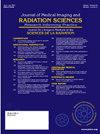Exploring communication gaps and parental needs during paediatric CT scan risk-benefit dialogue in resource-constrained facilities
IF 1.3
Q3 RADIOLOGY, NUCLEAR MEDICINE & MEDICAL IMAGING
Journal of Medical Imaging and Radiation Sciences
Pub Date : 2024-12-10
DOI:10.1016/j.jmir.2024.101816
引用次数: 0
Abstract
Background
Clear communication during informed consent is crucial in paediatric computed tomography (CT) procedures, particularly in resource-constrained settings. CT offers valuable diagnostic information but carries potential radiation risks, especially for paediatric patients. Parents play a critical role in decision-making, necessitating thorough risk-benefit discussions. This study aimed to explore parental experiences regarding risk-benefit communication during their children's CT scans in under-resourced healthcare facilities.
Methods
A qualitative approach with a descriptive design was employed. Semi-structured interviews were conducted with 13 purposefully selected and consenting parents accompanying paediatric patients for CT scans at two public hospitals. Data were analysed using Tesch's eight-step method and ATLAS.ti software.
Results
Participants were parents of children aged 0–10 years (8 males, 5 females), with 11 making their first visit to the CT department. Three main themes emerged: (1) Compromised consenting process, characterised by inadequate explanation of consent and limited risk-benefit communication; (2) Procedural information deficiency, including minimal communication about the procedure and lack of information on examination results; and (3) Preference for improved communication, with parents expressing a desire for comprehensive information and varied opinions on who should disseminate this information. Parents reported feeling uninformed, anxious, and unable to make well-informed decisions due to communication gaps.
Conclusions
Significant improvements are needed in risk-benefit communication during paediatric CT scans. Healthcare providers should use simplified language, visual aids, and patient-centred discussions to enhance understanding and reduce parental anxiety. Radiographers should allocate sufficient time for discussions, involve referring physicians when necessary, and document the informed consent process thoroughly. Addressing these issues can improve patient experiences and contribute to positive health outcomes in resource-constrained settings.
在资源有限的设施中,探讨儿童CT扫描风险-收益对话中的沟通差距和家长需求。
背景:在儿科计算机断层扫描(CT)过程中,知情同意时的明确沟通至关重要,尤其是在资源有限的情况下。CT 可提供有价值的诊断信息,但也有潜在的辐射风险,尤其是对儿科患者而言。家长在决策中起着至关重要的作用,因此有必要进行全面的风险收益讨论。本研究旨在探讨在资源匮乏的医疗机构中,父母在为子女进行 CT 扫描时与子女进行风险-效益沟通的经验:方法:采用描述性设计的定性方法。在两家公立医院有目的地挑选了 13 位同意陪同儿科患者进行 CT 扫描的家长,对他们进行了半结构化访谈。采用 Tesch 的八步骤法和 ATLAS.ti 软件对数据进行了分析:参与者均为 0-10 岁儿童的家长(8 男 5 女),其中 11 人是首次到 CT 部门就诊。结果显示出三大主题:(1) 征得同意的过程受到影响,其特点是对同意的解释不充分以及风险-效益沟通有限;(2) 程序性信息不足,包括对程序的沟通极少以及缺乏有关检查结果的信息;(3) 希望改善沟通,家长们表示希望获得全面的信息,并对由谁来传播这些信息表达了不同的意见。家长们表示,由于沟通方面的不足,他们感到不知情、焦虑,无法做出知情决定:结论:儿科 CT 扫描过程中的风险-收益沟通需要大力改进。医疗服务提供者应使用简化语言、直观教具和以患者为中心的讨论来加深理解并减少家长的焦虑。放射技师应为讨论分配充足的时间,必要时让转诊医生参与进来,并完整记录知情同意过程。在资源有限的情况下,解决这些问题可以改善患者的就医体验,并有助于取得积极的健康结果。
本文章由计算机程序翻译,如有差异,请以英文原文为准。
求助全文
约1分钟内获得全文
求助全文
来源期刊

Journal of Medical Imaging and Radiation Sciences
RADIOLOGY, NUCLEAR MEDICINE & MEDICAL IMAGING-
CiteScore
2.30
自引率
11.10%
发文量
231
审稿时长
53 days
期刊介绍:
Journal of Medical Imaging and Radiation Sciences is the official peer-reviewed journal of the Canadian Association of Medical Radiation Technologists. This journal is published four times a year and is circulated to approximately 11,000 medical radiation technologists, libraries and radiology departments throughout Canada, the United States and overseas. The Journal publishes articles on recent research, new technology and techniques, professional practices, technologists viewpoints as well as relevant book reviews.
 求助内容:
求助内容: 应助结果提醒方式:
应助结果提醒方式:


